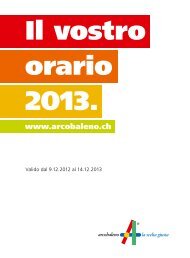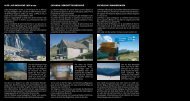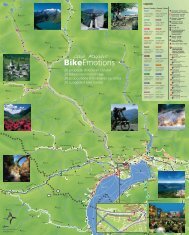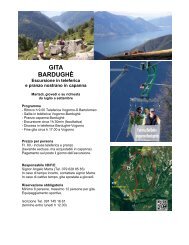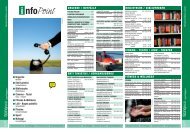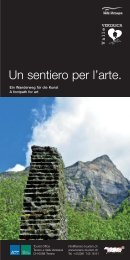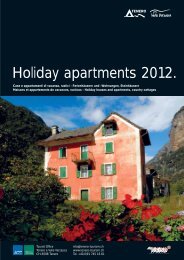You also want an ePaper? Increase the reach of your titles
YUMPU automatically turns print PDFs into web optimized ePapers that Google loves.
<strong>Tenero</strong>.Paradiso dei campeggi - CampingparadiesParadis des campings - Camping paradiseTourist Office<strong>Tenero</strong> e <strong>Val</strong>le <strong>Verzasca</strong>CH-6598 <strong>Tenero</strong>info@tenero-tourism.chwww.tenero-tourism.chTel. +41(0) 91 745 16 61
Fra lagoe collina<strong>Tenero</strong> affonda le sue radici nell’azzurro del LagoMaggiore, il Verbanus dei romani. Il sigillosettentrionale lo danno i fiumi <strong>Verzasca</strong> e <strong>Ticino</strong>,che addolciscono la loro corsa nel placidoabbraccio delle acque lacustri. Non è una focequalunque, ma un paradiso della natura, rigorosamenteprotetto (le Bolle di Magadino), regno di unricchissimo popolo di uccelli stanziali e migratori.In questo magnifico scenario troviamo numerosicampeggi apprezzati a livello internazionale.Affacciati direttamente sul lago, dispongono dispiagge sabbiose e sono perfettamente attrezzatiper offrire al turista un’indimenticabile vacanza acontatto con la natura.Anche il Centro sportivo nazionale della gioventù,firmato dall’architetto Mario Botta, è molto frequentatoda un popolo multietnico, specchio fedele dellaConfederazione, che si educa divertendosi “en pleinair”, libero e felice sull’intero arco dell’anno.Ma la regione offre molte altre possibilità diesercitare degli sport: dai più tradizionali (percorsovita, bicicletta, equitazione, tennis, ecc.), a quellipiù inusuali o estremi (bungy jumping, paracadutismo,go-kart, palestra di bouldering, ecc.).Naturalmente non mancano gli sport acquatici(sci nautico, wakeboard, banana boat, ecc.).Le coltivazioni scandiscono la pianura alluvionaledel <strong>Ticino</strong> e offrono l’ospitalità di alcuni centriagrituristici oltre che dei piacevoli itinerari per passeggiate a piedi o in bicicletta.Le colline, che si estendono da <strong>Tenero</strong> a Cugnasco, sono invece disegnatedalle geometriche scacchiere dei vigneti, curati con rigore e passione danumerosi produttori di ottimi vini.A Gordola inizia la strada della <strong>Verzasca</strong>, sospesa tra la forra cupa e i vignetiche fasciano la collina e che si chiudono sul Sassariente, elegante triangoloroccioso che è la specola ideale per abbracciare tutto il bacino svizzero delVerbano. A ovest lo sguardo arriva fino alle Isole di Brissago (Eden botanico), adAscona (perla del Lago Maggiore e meta conosciuta per lo shopping di qualità,per il suo golf a 18 buche e il New Orleans Jazz Festival), e a Locarno, centro digrandi manifestazioni, prima fra tutte il Festival internazionale del Film. A sudecco la magnifica riviera del Gambarogno e ad est Bellinzona, cittadina famosaper i suoi castelli medioevali dichiarati patrimonio mondiale dell’umanità.
ZwischenSee und Hügeln<strong>Tenero</strong> taucht seine Wurzeln in den blauen Lago Maggiore, den Verbanus der Römer. Die nördlicheBegrenzung bilden die Flüsse <strong>Verzasca</strong> und <strong>Ticino</strong>, deren Lauf sich besänftigt in die ruhigen Gewässer desSees ergiesst. Es ist nicht irgendeine Mündung, sondern ein Naturparadies, das unter strengem Schutzsteht (die Bolle di Magadino), das Reich eines vielfältigen gefiederten Volkes von einheimischen Vogelartenund Zugvögeln.In dieser wunderschönen Umgebung befinden sich zahlreiche international geschätzte Campingplätze.Sie liegen direkt am Seeufer, verfügen über Sandstrände und sind perfekt ausgerüstet, um Touristenunvergessliche Ferien in Berührung mit der Natur zu bieten.Auch das Centro sportivo nazionale della gioventù, das nationale Jugendsportzentrum, das die Handschriftdes Architekten Mario Botta trägt, wird von einem Publikum verschiedenster Herkunft, als einem getreuenAbbild der vielfältigen Bevölkerung der Eidgenossenschaft, rege genutzt; es wird an der frischen Luft Sportgetrieben und trainiert, frei und froh das ganze Jahr über.Die Region bietet aber auch viele andere Sportmöglichkeiten: von dentraditionellsten (Vitaparcours, Radfahren, Reiten, Tennis usw.) bis hin zuden ungewöhnlichsten und waghalsigsten (Bungy Jumping,Fallschirmspringen, Go-Kart, Boulderhalle usw.). Natürlich fehlen auchdie Wassersportarten nicht (Wasserski, Wakeboard, Banana Boat usw.).Die Anbau-Kulturen prägen die Ebene des Flussdeltas des <strong>Ticino</strong> undeinige agrotouristische Zentren bieten ihre Gastfreundschaft an, nebenangenehmen Routen für Spaziergänge zu Fuss oder für Fahrradtouren.Die Hügel, die sich von <strong>Tenero</strong> nach Cugnasco erstrecken, sindhingegen schachbrettartig gezeichnet von den Rebbergen, die vonzahlreichen Produzenten ausgezeichneter Weine mit Enthusiasmusgehegt und gepflegt werden.In Gordola beginnt die Strasse der <strong>Verzasca</strong>, gleichsam hängend verläuftzwischen der finsteren Schlucht und den Reben, die den Hügelumschliessen und die amFusse des Sassarienteenden, einem elegantenFelsendreieck, das einenidealen Aussichtspunkt überdas Schweizer Becken desLago Maggiore bildet. ImWesten reicht der Blick biszu den Brissago-Inseln (einem botanischen Paradies), nach Ascona (derPerle des Lago Maggiore, bekannt für gehobene Einkaufsmöglichkeiten,seinen 18-Loch-Golfplatz und sein New Orleans Jazz Festival), und nachLocarno, dem Zentrum für Grossveranstaltungen, allen voran dasInternationale Filmfestival. Im Süden erblickt man hingegen dasprachtvolle Ufer von Gambarogno und im Osten Bellinzona mit seinenmittelalterlichen Burgen, die von der UNESCO in die Liste desWeltkulturerbes aufgenommen wurden.
Entre lacet colline<strong>Tenero</strong> plonge ses racines dans l’azur du Lac Majeur, le Verbanus des Romains. Le cachet septentrionalest donné par les rivières <strong>Verzasca</strong> et <strong>Ticino</strong>, qui adoucissent leur course dans l’étreinte paisible deseaux lacustres. Ce n’est pas une embouchure quelconque, mais un paradis de la nature, rigoureusementprotégé (les Bolle de Magadino), règne d’une population richissime d’oiseaux migrateurs et non.Dans ce décor magnifique nous trouvons de nombreux campings appréciés au niveau international. Ilsdonnent directement sur le lac, disposent de plages sablonneuses et sont parfaitement équipés pouroffrir au touriste une vacance inoubliable au contact de la nature.Même le Centre sportif national de la jeunesse, signé par l’architecte Mario Botta, est très fréquentépar une population multiethnique, miroir fidèle de la Confédération, qui s’exerce en s’amusant en pleinair, libre et heureuse tout au long de l’année.Mais la région offre beaucoup d’autres possibilités de pratiquer des sports: des plus traditionnels(parcours vita, bicyclette, équitation, tennis, etc.) à ceux plus inhabituels ou extrêmes (bungy jumping,parachutisme, karting, bouldering (mur d’escalade en salle), etc.). Naturellement ne manquent pas lessports aquatiques (ski nautique, wakeboard, banana boat, etc.).Les cultures rythment la plaine alluviale du <strong>Ticino</strong> et offrent non seulement l’hospitalité de quelquescentres agritouristiques mais aussi d’agréables itinéraires pour promenades à pied ou à vélo. Lescollines, qui s’étendent de <strong>Tenero</strong> à Cugnasco, sont par contre couvertes par les dessins géométriquesen échiquiers des vignobles, soignés avec rigueur et passion par de nombreux producteurs d’excellentsvins.A Gordola commence la route de la <strong>Verzasca</strong>, suspendue entre le ravin profond et les vignobles quientourent la colline et qui s’arrêtent au pied du Sassariente, élégant triangle rocheux qui est l’observatoire idéal pour embrasser d’un regard tout lebassin suisse du Verbano. A l’ouest le regard arrive jusqu’aux Iles de Brissago (Eden botanique), à Ascona (perle du Lac Majeur et destinationconnue pour le shopping de qualité, pour son golf à 18 trous et le New Orleans Jazz Festival), et à Locarno, centre de grandes manifestations,première parmi toutes le Festival international du Film. Au sud voici la magnifique rivière du Gambarogno et à l’est Bellinzone, cité fameuse pour seschâteaux médiévaux inscrits au patrimoine mondial de l’humanité.
Between the hillsand the lake<strong>Tenero</strong> is situated on the shore of the blue Lake Maggiore, which theRomans used to call Verbanus. It is bordered in the north by the rivers<strong>Verzasca</strong> and <strong>Ticino</strong>, which mellow as they approach the placid watersof the lake. This is no ordinary river mouth but a rigorously protectedhaven for nature (the Bolle di Magadino nature reserve), home to a vastpopulation of sedentary and migratory birds.Set amidst this spectacular scenery are numerous world-renownedcamping sites. Located directly on the lake shore, they offer sandybeaches and are perfectly equipped for an unforgettable holiday in aunique natural setting.The national youth sports centre in <strong>Tenero</strong>, designed by the architectMario Botta, is also very popular with multiethnic visitors – a truereflection of the Swiss Confederation – who practise sports in the openair all year round, enjoyingthemselves at the sametime.However, the region offersmany other sports as well,from the more traditional(fitness exercise courses,cycling, horse-riding, tennisetc.) to the more unusual or extreme (bungee jumping, parachuting,go-karting, bouldering etc.) as well as water sports (waterskiing,wakeboarding, banana boat riding etc.).The alluvial plain of the <strong>Ticino</strong> river is largely cultivated and offersfarmhouse accommodation and scenic paths for walking and cycling.San GottardoSwitzerland<strong>Ticino</strong>The hills stretching from <strong>Tenero</strong> to Cugnasco are covered with a patchworkof vineyards carefully and passionately tended by numerous producers ofgood wine.From Gordola, a winding road leads up into the <strong>Verzasca</strong> valley, pastdeep gorges and the vine-covered hills at the foot of MountSassariente, an elegant triangular mountain of rock, which offers theideal vantage point for looking out across the Swiss portion of LakeMaggiore.To the west you can see the Brissago Islands (a botanical paradise),Ascona (the pearl of Lake Maggiore and a popular destination for qualityshopping, its eighteen-hole golf course and the New Orleans JazzFestival) and Locarno (the venue of many events including the famousLocarno International Film Festival); to the south lies the magnificentGambarogno riviera; and to the east Bellinzona, a town famous for itsmedieval castles, designated by UNESCO as a world heritage site.<strong>Val</strong>le <strong>Verzasca</strong><strong>Tenero</strong>LocarnoAsconaLago MaggioreLuganoBellinzona
<strong>Val</strong>le <strong>Verzasca</strong>.Cuore verde del <strong>Ticino</strong> - Grünes Herz des TessinsCoeur vert du Tessin - Green heart of <strong>Ticino</strong>Tourist Office<strong>Tenero</strong> e <strong>Val</strong>le <strong>Verzasca</strong>CH-6598 <strong>Tenero</strong>info@tenero-tourism.chwww.tenero-tourism.chTel. +41(0) 91 745 16 61
L’acqua e la pietra:entrate senza bussarePer favore, non credete ai viaggiatori del passato che dipingevano la <strong>Verzasca</strong> come una ”vallishorribilis”. Era un giudizio, o meglio un pregiudizio, figlio del tempo – il Settecento e l’Ottocento –quando i primi turisti-esploratori scoprivano un ambiente austero e selvaggio, così diverso da tanti altricostruiti da madre natura su disegni dolci e anche un po’ banali.Oggi il bello della <strong>Verzasca</strong> sta proprio nella sua “personalità”, che è rimasta quella di un tempo: unmicrocosmo originale, oasi felice e tanto lontana dall’urbanizzazione dilagante. Qui l’ambiente èancora quello genuino e intatto. Sempre più raro.Il suo fiume, perennemente verde, è un incantevole smeraldo che si insinua fra montagne incombenti.Le sue acque accarezzano rocce candide e modellate dal millenario fluire. Riflessi iridescenti e pozzetraslucide. Gioielli che non si possono comperare, ma si offrono senza pedaggi per piacevoli bagninelle calde giornate estive.Non c’è nulla di banalee di scontato in <strong>Verzasca</strong>. Inuclei armoniosi di case inpietra grezza, figliaschietta dellemontagne,sembrano messi lìad ascoltare il solee a scansare levalanghe. Modulicostruttivi di unasemplicitàfunzionale erazionale. Non èpassatismo ocompiacimentoretorico ritrovare isegni di una civiltàalpina altroveirrimediabilmentetrapassata.E poi le valli laterali, i laghiazzurri, le catene dei monti,anch’esse solari, da godere congratificante lentezza, quasi alpasso delle montagne, per nonbanalizzare le seducentiscoperte. Uno scrigno colmo distupori: rustiche cascine, forniaffumicati, cappelle e affreschidel passato. È lo charmediscreto delle cose d’altri tempi.Ma anche grotti e ristoranti peruna confortevole sosta chepermette di gustare sapori tipici.Camminare sulla copiosa retedei sentieri significa penetrarenell’anima del passato operosodella gente che ha saputoutilizzare tutte le risorse della natura,sempre rispettandola. Ne sono testimonii maggenghi e gli alpeggi, alcuni ancorasfruttati, altri abbandonati, altri ancorariutilizzati come capanne per gliescursionisti.Profumi e colori. Ci vuole poco perscoprire i giardini della natura e ipanorami che guardano lontano,abbracciando le cime delle “Grandi Alpi”,i laghi e la pianura italiana. Un belguardare fra terra e cielo che solo la ViaAlta e le numerose passeggiate della<strong>Verzasca</strong> possono offrire.
Wasser und Stein: tretenSie ein, ohne anzuklopfenBitte glauben Sie nicht den Reisenden aus der Vergangenheit, welche das <strong>Verzasca</strong>-Tal als eine „vallishorribilis“, ein schreckenerregendes Tal, bezeichnet haben. Dies war ein Urteil oder besser gesagt einVorurteil, ein Ausdruck des Zeitgeistes – des Achtzehnten und des Neunzehnten Jahrhunderts – als dieersten Touristen und Entdeckungsreisenden eine karge und wilde Landschaft entdeckten, die sich sostark von vielen anderen Schöpfungen der Mutter Natur von sanfter und auch etwas banaler Prägungunterschied.Heute besteht die Schönheit des <strong>Verzasca</strong>-Tals vor allem in seiner „Persönlichkeit“, welche die gleichewie früher geblieben ist: ein ursprünglicher Mikrokosmos, eine glückliche Oase und sehr weit entfernt vonder um sich greifenden Verstädterung. Hier ist die Umwelt noch echt und intakt. Etwas, das immerseltener wird.Sein Fluss, schimmernd grün, ist ein bezaubernder Smaragd, der sich zwischen bedrohlichen Felsendurchschlängelt. Sein Lauf umspielt weisse und durch tausende von Jahren vom Fliessen des Wassersgeformte Felsen. Leuchtende Lichtreflexe und durchscheinende Wasserbecken. Juwelen, die man nichtkaufen kann, die sich aber ohneEintrittspreis für ein angenehmes Badan heissen Sommertagen anbieten.Im <strong>Verzasca</strong>-Tal gibt es nichts Banalesund Berechnetes. Die harmonischenHäusergruppen aus Natursteinen, demechten Produkt der Berge, scheinen indie Landschaft eingefügt, um derSonne zuzuhören und den Lawinen zuentrinnen. Bauten von funktionaler undrationaler Einfachheit. Es ist keineNostalgie oder Schwärmerei, dieZeichen einer alpinen Kulturwiederzuentdecken, die andernortsunwiederbringlich verschwunden ist.Und dann die Seitentäler, die blauenSeen, die Bergketten im Sonnenlicht,man muss sie geniessen mitbeglückender Langsamkeit, gleichsam im Berglerschritt, um das Ungewöhnliche derverführerischen Entdeckungen zu empfinden. Ein Schrein voller Wunder: rustikale Häuser,rauchgeschwärzte Kamine, Kapellen und Fresken aus der Vergangenheit. Dies ist der diskreteCharme der Dinge aus anderen Zeiten. Aber auch Grotti und Restaurants für eine angenehme Rast,bei der typische Spezialitäten probiert werden können.Im reich verzweigten Wegnetz zu wandern, bedeutet, in die Seele der arbeitsintensivenVergangenheit der Bevölkerung vorzustossen, die es verstanden hatte, alle Ressourcen der Naturzu nutzen, und diese dennoch immer zu respektieren. Zeugen dafür sind die Maiensässe undAlpweiden; einige werden noch bewirtschaftet, andere sind verlassen, wieder andere werdenwieder als Berghütten für Wanderer genutzt.Düfte und Farben. Es braucht nicht viel, um die Gärten der Natur und die Ausblicke zu entdecken,die weit reichen und die Gipfel der „Hochalpen“, die Seen und die italienische Ebene umfassen. Einwunderbares Panorama zwischen Himmel und Erde, wie es nur die Via Alta und zahlreicheSpaziergänge im <strong>Verzasca</strong>-Tal bieten können.
L’eau et la pierre:entrez sans frapperS’il vous plaît, ne croyez pas les voyageurs du passé qui dépeignaient la <strong>Verzasca</strong> comme une”vallis horribilis”. C’était un jugement, ou mieux un préjugé, fils de l’époque – le dix-huitième et ledix-neuvième siècle – où les premiers touristes-explorateurs découvraient un environnementaustère et sauvage, si différent de tant d'autres réalisés par mère nature selon des desseins douxet aussi un peu banals.Aujourd’hui la beauté de la <strong>Verzasca</strong> réside précisément dans sa “personnalité” qui est restéecelle de jadis: un microcosme original, oasis heureuse et si lointaine de l’urbanisationenvahissante. Ici l’environnement est encore authentique et intact. Toujours plus rare.Sa rivière, perpétuellement verte, est un enchantement émeraude qui se faufile entre lesmontagnes surplombantes. Ses eaux caressent des roches blanches et modelées parl´écoulement millénaire. Des reflets iridescents et des flaques translucides. Des bijoux que l’on nepeut pas acheter, mais qui s’offrent sans péages pour d’agréables bains durant les chaudesjournées estivales.Rien n’est banal ni escompté dans la <strong>Verzasca</strong>. Les groupesharmonieux de maisons en pierre brute, pur produit desmontagnes, semblent posés là pour contempler le soleil et esquiverles avalanches. Des modules de construction d’une simplicitéfonctionnelle et rationnelle. Retrouver les signes d’une civilisationalpine ailleurs irrémédiablement passée n’est pas du passéisme ouune complaisance rhétorique.Et puis les vallées latérales, les lacs azurs, les chaînes des montagnes,elles aussi radieuses, à apprécier avec une gratifiante lenteur, presqueau pas des montagnes, pour ne pas banaliser les séduisantesdécouvertes. Un écrin plein de stupeurs: des “cascine” rustiques(anciennes étables/fromageries), des fours noircis par la fumée, deschapelles et fresques du passé. C’est le charme discret des chosesd’autrefois. Mais également les “grotti” et restaurants pour uneconfortable pause qui permet de déguster des saveurs typiques.Cheminer sur le riche réseaude sentiers signifie pénétrerl’âme du passé laborieuxdes gens qui ont su utilisertoutes les ressources de lanature, toujours en larespectant. En sont lestémoins les “maggenghi”(prairies) et les alpages, certains encore exploités, d’autres abandonnés,d’autres encore réutilisés comme cabanes pour les randonneurs.Parfums et couleurs. Il en faut peu pour découvrir les jardins de lanature et les panoramas grandioses à perte de vue, embrassant lescimes des “Grandes Alpes”, les lacs et la plaine italienne. Un beaupaysage à admirer entre ciel et terre que seulement la Via Alta et lesnombreuses promenades de la <strong>Verzasca</strong> peuvent offrir.
Welcome to a worldof water and stonePay no attention to the travellers of yesteryear,who depicted the <strong>Verzasca</strong> valley as a vallishorribilis: that was their own personal,prejudiced opinion, typical of the eighteenth andnineteenth centuries, when the first travellers andexplorers discovered a harsh, wild environmentso different from many others sculpted bymother nature along gentle and somewhatmonotonous lines.Today, the beauty of the <strong>Verzasca</strong> valley lies inits very personality, which has remainedunchanged to this day. The valley is a uniquemicrocosm; it is an oasis of tranquillityuntouched by urbanization. Here, theenvironment has remained genuine and unspoilt– more and more of a rarity these days.The valley’s enchanting emerald green riverwinds its way through the majestic mountains,caressing the smooth boulders, which it hassculpted over the centuries. Its iridescentstreams and crystal-clear pools are jewels thatmoney cannot buy and make beautiful bathinglocations during the hot summer days.There is nothing monotonous or ordinary about<strong>Verzasca</strong>: The harmonious clusters of stonecottages – genuine products of the mountains –look as though they have been placed there toenjoy the sun and escape the avalanches. They are simple dwellingsconstructed in a functional and rational manner. It is neither traditionalismnor rhetorical pleasure that allures visitors to rediscover this ancientmountain culture, which has long disappeared elsewhere.<strong>Verzasca</strong>’s side valleys, blue lakes and sunny mountain chains are tobe enjoyed at a gratifyingly slow pace, almost at the same rhythm asthat of the mountains, so as not to trivialize the fascinating discoveries.The valley is a treasure trove of wonders just waiting to be discovered:for example, rustic farmhouses, ovens blackened by smoke andancient chapels and frescos. It offers the discreet charm of objects ofolden times as well as grottos and restaurants providing a comfortableplace in which to stop and savour the typical dishes of the region.Hiking along the dense network of footpaths is the perfect way toreach the very soul of the hard-working people of the past, whoexploited all the resources that nature had to offer whilst respectingthe natural environment inwhich they lived. Primeexamples of theiractivities include theirmountain pastures anddwellings, some of whichare used to this day,whilst others areabandoned, and others still are used as mountain cabins forexcursionists.<strong>Verzasca</strong> is a natural garden full of colours and scents and offersmagnificent views stretching far away into the distance. Particularlystunning are those of the Alps, the lakes and the Italian plain seen fromthe Via Alta – a high mountain path running along mountain ridges andover various peaks – and numerous other mountain paths.






